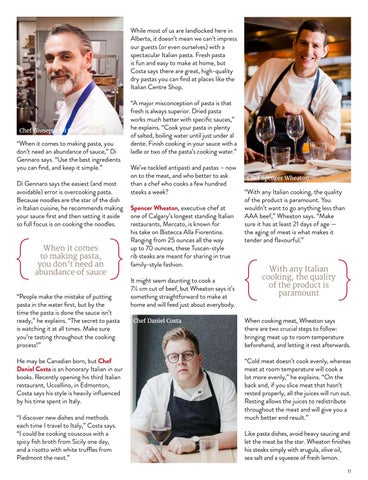While most of us are landlocked here in Alberta, it doesn’t mean we can’t impress our guests (or even ourselves) with a spectacular Italian pasta. Fresh pasta is fun and easy to make at home, but Costa says there are great, high-quality dry pastas you can find at places like the Italian Centre Shop.
Chef Giuseppe Di Gennaro
“When it comes to making pasta, you don’t need an abundance of sauce,” Di Gennaro says. “Use the best ingredients you can find, and keep it simple.” Di Gennaro says the easiest (and most avoidable) error is overcooking pasta. Because noodles are the star of the dish in Italian cuisine, he recommends making your sauce first and then setting it aside so full focus is on cooking the noodles.
When it comes to making pasta, you don’t need an abundance of sauce “People make the mistake of putting pasta in the water first, but by the time the pasta is done the sauce isn’t ready,” he explains. “The secret to pasta is watching it at all times. Make sure you’re tasting throughout the cooking process!” He may be Canadian born, but Chef Daniel Costa is an honorary Italian in our books. Recently opening his third Italian restaurant, Uccellino, in Edmonton, Costa says his style is heavily influenced by his time spent in Italy. “I discover new dishes and methods each time I travel to Italy,” Costa says. “I could be cooking couscous with a spicy fish broth from Sicily one day, and a risotto with white truffles from Piedmont the next.”
“A major misconception of pasta is that fresh is always superior. Dried pasta works much better with specific sauces,” he explains. “Cook your pasta in plenty of salted, boiling water until just under al dente. Finish cooking in your sauce with a ladle or two of the pasta’s cooking water.” We’ve tackled antipasti and pastas – now on to the meat, and who better to ask than a chef who cooks a few hundred steaks a week? Spencer Wheaton, executive chef at one of Calgary’s longest standing Italian restaurants, Mercato, is known for his take on Bistecca Alla Fiorentina. Ranging from 25 ounces all the way up to 70 ounces, these Tuscan-style rib steaks are meant for sharing in true family-style fashion. It might seem daunting to cook a 7½ cm cut of beef, but Wheaton says it’s something straightforward to make at home and will feed just about everybody. Chef Daniel Costa
Chef Spencer Wheaton
“With any Italian cooking, the quality of the product is paramount. You wouldn’t want to go anything less than AAA beef,” Wheaton says. “Make sure it has at least 21 days of age — the aging of meat is what makes it tender and flavourful.”
With any Italian cooking, the quality of the product is paramount When cooking meat, Wheaton says there are two crucial steps to follow: bringing meat up to room temperature beforehand, and letting it rest afterwards. “Cold meat doesn’t cook evenly, whereas meat at room temperature will cook a lot more evenly,” he explains. “On the back end, if you slice meat that hasn’t rested properly, all the juices will run out. Resting allows the juices to redistribute throughout the meat and will give you a much better end result.” Like pasta dishes, avoid heavy saucing and let the meat be the star. Wheaton finishes his steaks simply with arugula, olive oil, sea salt and a squeeze of fresh lemon. 11
